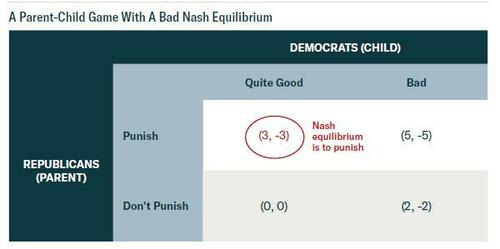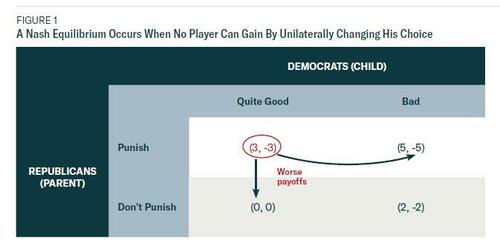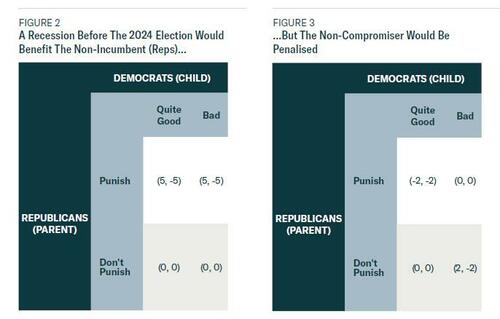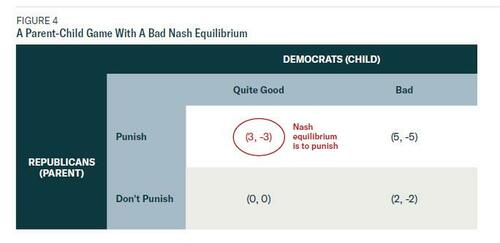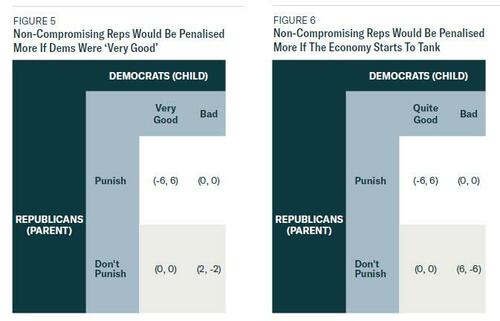The Debt Ceiling Game Is Parent-Child With A Bad Nash Equilibrium
By Dhaval Joshi of BCA Research
The Debt Ceiling Game Is Parent-Child With A Bad Nash Equilibrium
- In game theoretical terms, the debt ceiling standoff is the Parent-Child game.
- The ‘Child’ is the Democrats who can cut spending a lot (be very good), cut spending a little (be quite good), or not cut spending (be bad). The ‘Parent’ is the Republicans who can refuse to lift the debt ceiling (punish), or lift the debt ceiling (not punish).
- For the Republicans, the best strategy is not to lift the debt ceiling unless the Democrats cut spending a lot, or unless the economy starts to tank.
- For the Democrats, the required spending cuts will lessen as the economy starts to tank, but the likelihood will increase that a recession damages President Biden’s re-election hopes.
- The debt ceiling game’s endpoint will avoid default only if it implies economic pain.
The 2001 four-times Oscar winning movie A Beautiful Mind starred Russell Crowe as John Nash, the mathematician who revolutionized game theory by introducing the concept of the ‘Nash equilibrium’. It’s a great movie, well worth watching if you haven’t already.
Nash’s big breakthrough was to define the steady state of a game, by identifying the combination of choices from which no player can gain by unilaterally changing his choice. This is the Nash equilibrium. When all players know each other’s payoffs, the Nash equilibrium becomes the game’s logical endpoint (Figure 1).
Right now, the Democrats and Republicans are playing a game that our US Political Strategists have long warned poses a higher-than-usual risk of national debt default BCA Research – Shades Of Gridlock: Risk Of US Debt Default. The Democrats (Dems) must concede spending cuts for the Republicans (Reps) to lift the debt ceiling and prevent the US government from defaulting on its debt. This raises the questions: What is the game? What are the payoffs? And what is the Nash equilibrium?
The Debt Ceiling Game Is The Parent-Child Game With A Bad Nash Equilibrium
Game theorists, as well as parents, will recognize the debt ceiling standoff as the Parent-Child game, in which “the child” can be good or bad, and “the parent” can punish or not punish. In this case, the child is the Dems who can cut spending a lot (be very good), cut spending a little (be quite good), or not cut spending (be bad). The parent is the Reps who can refuse to lift the debt ceiling (punish), or lift the debt ceiling (not punish).
What are the payoffs to the Reps and Dems? In this case, the payoffs come from the overarching prize of winning the 2024 Presidential Election. This is because each of the six combination of choices produces a potential swing from independent voters. Given that a Reps gain is a Dems loss, each payoff takes the form (X, -X), where the first number is the likely swing to the Reps, and the second is the mirror-image swing from the Dems.
The payoffs are the sum of two components. The first component comes from the economic impact. A US debt default would almost guarantee a recession, and a recession within a year or so from a Presidential Election tends to generate a huge swing to the non-incumbent party, in this case the Reps. Say the swing is 5 percent. Then the payoff for this component would be (5, -5) (Figure 2).
President Biden himself has recently acknowledged this gain to the Reps and loss to the Dems:
“I think there are some MAGA Republicans in the House who know the damage that (a debt default) would do to the economy, and because I am president, and the president’s responsible for everything, Biden would take the blame”
Working against this is the second component, which measures independent voters recoiling from the party that is the non-compromiser, and is therefore to blame for the recession.
If the Dems are ‘quite good’, meaning that they cut spending a little, but the Reps still ‘punish’, then this may cost the Reps some votes for being the non-compromiser, say (-2, 2). Note that the specific number here is not important, just that the loss for being the non-compromiser is less than the gain from recession (Figure 3).
So, what is the Nash equilibrium in this game setup? Unfortunately, it is a bad equilibrium in which the Dems are ‘quite good’ but the Reps best strategy is ‘punish’. It is a Nash equilibrium because neither side can gain by unilaterally changing its choice. For the Reps, as Biden has alluded, the gain from a recession (5, -5) outweighs their loss from being the non-compromiser (-2, 2), giving them a payoff of (3, -3), compared to (0, 0) if they compromise (Figure 4).
How To Shift To A Good Nash Equilibrium
Now let’s say that the Reps’ loss from being the non-compromiser becomes larger than their gain from a recession. This could happen in one of two ways. Either because the Dems are ‘very good’, meaning they cut spending a lot, making it tough to justify ‘punish’. Or because the economy starts to tank, meaning that being the non-compromiser becomes very costly. Say the Reps payoff for being the non-compromiser worsens to (-6, 6) (Figure 5 and Figure 6).
In either case, the Nash equilibrium shifts to a good equilibrium in which the Dems cut spending a lot in a non-tanking economy, or cut spending a little in a tanking economy. And the Reps best strategy is ‘don’t punish’, meaning to lift the debt ceiling.
Some Conclusions
It is not my intention to take sides in the debt ceiling standoff. Rather, it is just to point out the best strategies in a plausible game theoretical setup, and what it means for the game’s endpoint.
For the Reps, the best strategy is not to lift the debt ceiling if the Dems cut spending a little, until the economy starts to tank, because this is when the cost of being the non-compromiser becomes penalizing (Figure 7 and Figure 8).
For the Dems, cutting spending a lot will be politically difficult. The required spending cuts will lessen as the economy starts to tank, but the likelihood will increase that a recession damages Biden’s re-election hopes.
This raises the question, what if the game finishes at a different endpoint to the Nash equilibriums – for example, with the Dems cutting spending a little in a non-tanking economy and the Reps lifting the debt ceiling? This would imply one of the following:
One possibility is that neither the Reps nor the Dems understand the game theory. However, Biden’s remarks suggest that they do, at least implicitly.
Another possibility is that the Reps are altruistic, putting the country before their own political ambitions. But call me cynical, I don’t believe that any political party would give a free pass to its opponent unless the country were in crisis, which it is not. Meaning, the Reps can wait until the market or the economy starts to tank.
A third possibility is that the Reps are convinced that a recession is coming anyway, so why force it and risk looking like the bad guy? In this case, appearing to be the good guy might be a win-win for the Reps, but a bad omen for the economy.
To sum up, the debt ceiling game’s Nash equilibrium is a bad equilibrium in which the Dems are ‘quite good’ but the Reps best strategy is ‘punish’ until the economy starts to tank. The debt ceiling game’s endpoint will avoid default only once it implies economic pain. Hence, it reinforces our 6-12 month horizon defensive positioning in asset allocation, sector allocation, and currency allocation.
Tyler Durden
Thu, 05/25/2023 – 20:40
via ZeroHedge News https://ift.tt/NWDx7TO Tyler Durden
